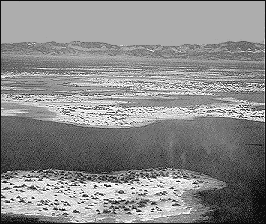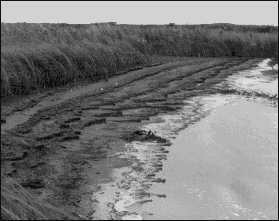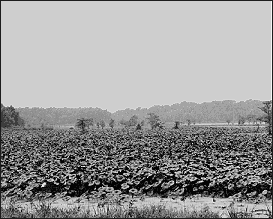
 |
| Plate 45.--Classification: SYSTEM Lacustrine, SUBSYSTEM Littoral, CLASS Unconsolidated Shore, SUBCLASS Mud, WATER REGIME Seasonally Flooded, WATER CHEMISTRY Hypersaline. (Salt Lake County, Utah; June 1973; Photo by V. Carter) |
 |
| Plate 46.--Two habitats are shown here. Classification of exposed areas: SYSTEM Lacustrine, SUBSYSTEM Littoral, CLASS Unconsolidated Shore, SUBCLASS Mud, WATER REGIMES, Intermittently Flooded (light-colored soil) and Seasonally Flooded (darker soil along water's edge), WATER CHEMISTRY Mixosaline, SOIL Mineral. Classification of inundated areas: SYSTEM Lacustrine, SUB-SYSTEM Littoral, CLASS Unconsolidated Bottom, SUBCLASS Mud, WATER REGIME Semipermanently Flooded, WATER CHEMISTRY Mixosaline, SOIL Mineral. Greasewood (Sarcobatus vermiculatus), salt grass (Distichlis spicata), and rushes (Juncus spp.) are scattered across the flats. Because annual precipitation averages only about 18 cm (7 in) here, these wetlands are heavily dependent upon snowpack in the surrounding mountains as a source of water. (Saguache County, Colorado; Photo by R. M. Hopper) |
 |
| Plate 47.--Classification: SYSTEM Lacustrine, SUBSYSTEM Littoral, CLASS Unconsolidated Shore, SUBCLASS Organic, WATER REGIME Seasonally Flooded, WATER CHEMISTRY Fresh. This beach is only 15 m (50 ft) long and 2 m (6-7 ft) wide. Such organic shores are common in certain areas of the Yukon-Kuskokwim Delta, and many are considerably larger than the one shown here. Evidence of the decline in lake levels over the summer can be seen in the series of low ridges in the peat. Surrounding vegetation includes sedge (Carex lyngbyei), bluejoint (Calamagrostis canadensis), and willows (Salix spp.). (Talik River area, Yukon- Kuskokwim Delta, Alaska; July 1985; Photo by F. C. Golet) |
 |
| Plate 48.--Classification: SYSTEM Lacustrine, SUBSYSTEM Littoral, CLASS Emergent Wetland, SUBCLASS Nonpersistent, DOMINANCE TYPE Nelumbo lutea, WATER REGIME Permanently Flooded, WATER CHEMISTRY Fresh-Circumneutral, SOIL Mineral, SPECIAL MODIFIER Impounded. Subordinate plants are duckweeds (Lemna spp.) and bald cypress (Taxodium distichum). (Obion County, Tennessee; September 1975; Photo by V. Carter) |